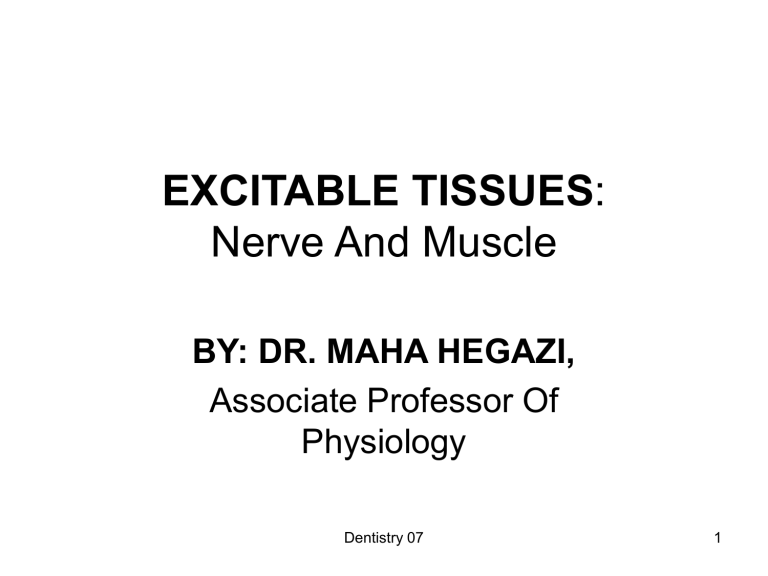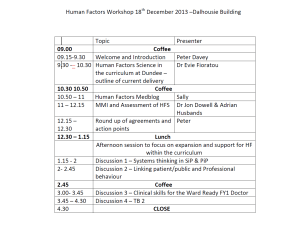EXCITABLE TISSUES: Nerve And Muscle For 2nd Year Dental

EXCITABLE TISSUES :
Nerve And Muscle
BY: DR. MAHA HEGAZI,
Associate Professor Of
Physiology
Dentistry 07 1
Learning objectives:
by the end of these lectures the student should know
• Morphology of the nerve cell & functional organization of neurons
• Excitation & conduction along the nerve (local & propagated action potentials)
• Resting membrane potential ( causes & recording)
• Action potential (ionic bases & recording) electrical changes that occur on a nerve on stimulation.
• Compound action potential
• Changes in excitability during electronic potential (local) & action potential
• All or non law
• Saltatory conduction
• Energy sources & metabolism of nerve
• Properties of mixed nerve
• Nerve types & functions
Dentistry 07 2
Nerve cells:
• The neurons are the basic building blocks of the nervous system, their axons may or may not myelinated.
• The myelin sheath is produced by the Schwan cells. It envelops the axon except at the ends & the nodes of Ranvier
• The impulse is conducted faster in myelinated than unmyelinated nerves.
Dentistry 07 3
Resting Membrane Potential
Definition: it is the potential difference recorded across the cell membrane at rest.
• Causes:
• 80% caused by selective permeability of the cell membrane
The K+ diffuses out the cell & Na+ diffuses inside the cell according to concentration gradient. The K+ permeability is 50-75 folds more than Na+
• 20% is caused by the Na+ K+ pump an active process that needs energy taken from ATP.
This is very important to maintain the concentration gradient across the cell membrane
Dentistry 07 4
Resting Membrane Potential (V
r
)
Dentistry 07 5
Sodium-Potassium Exchange Pump
Dentistry 07 6
• Significance:
• PROTEINS have a negative charge & can not leave the cell to the outside
• K+ efflux is not accompanied by an equal influx of anions & membrane is maintained in a polarized state with the outside positive relative to the inside making the
RMP for a nerve to be - 70 mV
Dentistry 07 7
Recording of Resting and action potentials
• It is recorded by cathode
– ray oscilloscope
Voltmeter it is negative in polarized
( resting, the membrane can be excited ) state with the potential difference inside the cell membrane is negative relative to the outside.
+
+
+
+
–
–
+
– –
+
–
–
–
– –
+
+
–
–
+
+
+
Dentistry 07 8
Excitation & conduction:
Nerve cells have low threshold for excitation.
The stimulus may be electrical, chemical or mechanical.
Two types of potentials may be produced
• Local (Non-propagated action potential ) named after its location synaptic, generator or electronic potential
• PROPAGATED ACTION
POTENTIAL (nerve impulse).
Both are due to changes in the conduction of ions across the cell membrane that are produced by alternations in the ion channels
Dentistry 07 9
Recording membrane potential
mV
+ 60 -
+ 30 -
0 -
- 30 -
- 60 -
- 90 -
Electrotonic potential
Localized non propagated
Action potential
Dentistry 07 10
• All or non law:
• Application of a threshold stimulus either produces a full response or not at all.
• Further increase in the intensity of a stimulus produces no increment or other changes in action potential.
• The action potential failed to occur if the stimulus is subthreshold, it produces only local changes with no propagation.
• Latent period in a nerve : it is a period corresponding to the time taken from the site of simulation till the recording electrode.
Dentistry 07 11
Stimulation of a nerve produces:
• ELECTRICAL CHANGES CALLS ACTION
POTENTIAL
• EXCITABILITY CHANGES.
• THERMAL CHANGES
Dentistry 07 12
The action potential (AP)
• An action potential is:
– A regenerating depolarization of membrane potential that propagates along an excitable membrane.
[propagates = conducted without decrement (an ‘active’ membrane event)]
[excitable = capable of generating action potentials] +70
• Action potentials:
– are all-or-none events
• need to reach threshold
– have constant amplitude
0
(mV)
• do not summate
– are initiated by depolarization
– involve changes in permeability
– rely on voltage-gated ion channels
-80
1 ms
E
Na downstroke
E
K 13
Threshold and Action Potentials
• Threshold – membrane is depolarized by 15 to 20 mV
• Established by the total amount of current flowing through the membrane
• Weak (subthreshold) stimuli are not relayed into action potentials
• Strong (threshold) stimuli are relayed into action potentials
• All-or-none phenomenon – action potentials
Dentistry 07 either happen completely, or not at all 14
Electrotonic potential
The Action Potential
Equilibrium potential of sodium (+60 mV)
- 75 mV
K Na K K Na
Passive increase in positive charge
Resting potential (-75 mV)
Equilibrium potential of potassium (-95 mV)
Dentistry 07 15
threshold
Electrotonic potential
The Action Potential
Equilibrium potential of sodium (+60 mV)
- 55 mV
K Na K K Na
Opening of voltage-gated sodium channel
Resting potential (-75 mV)
Equilibrium potential of potassium (-95 mV)
Dentistry 07 16
The Action Potential
Equilibrium potential of sodium (+60 mV)
- 40 mV
K Na K K Na
Depolarisation due to sodium influx
Electrotonic potential
Opening of voltage-gated sodium channel
Resting potential (-75 mV)
Equilibrium potential of potassium (-95 mV)
Dentistry 07 17
The Action Potential voltage-gated sodium channels turn to the inactivation phase
Equilibrium potential of sodium (+60 mV)
+ 50 mV
K Na K K Na
Depolarisation due to sodium influx
Electrotonic potential
Inactivation of voltage-gated sodium channel
Resting potential (-75 mV)
Equilibrium potential of potassium (-95 mV)
Dentistry 07 18
The Action Potential
Equilibrium potential of sodium (+60 mV)
+ 50 mV
K Na K K Na
Depolarisation due to sodium influx
Electrotonic potential opening of voltage-gated potassium channel
Resting potential (-75 mV)
Equilibrium potential of potassium (-95 mV)
Dentistry 07 19
The Action Potential
Equilibrium potential of sodium (+60 mV)
- 85 mV
Depolarisation due to sodium influx
Repolarization due to potassium influx
K Na K K Na opening of voltage-gated potassium channel
Electrotonic potential
Resting potential (-75 mV)
Equilibrium potential of potassium (-95 mV)
Dentistry 07 20
The Action Potential
Membrane potential approaches the E
Na and voltage-gated sodium channels turn to the inactivation phase
Equilibrium potential of sodium (+60 mV)
- 75 mV
Depolarisation due to sodium influx repolarization due to potassium influx
K Na K K Na closing of voltage-gated potassium channel
Electrotonic potential
Hyperpolarising afterpotential
Dentistry 07
Resting potential (-75 mV)
Repolarisation due to potassium influx
21
The Action Potential
Inactivation of voltage-controlled sodium channel
Equilibrium potential of sodium (+60 mV)
Opening of voltagecontrolled sodium channel threshold
Electrotonic potential
Opening of voltagecontrolled potassium channel
Resting potential (-75 mV)
Hyperpolarization due to more outflux of potassium ions
Dentistry 07 22
The Action Potential (excitability changes)
Absolute refractory period
Relative refractory period
E
Na
(+60 mV)
Depolarisation
(due to sodium influx) afterdepolarization
Polarized state
(resting)
Hyperpolarising
Dentistry 07 afterpotential
Resting potential (-75 mV)
E
K
Action Potential Propagation
Dentistry 07 24
Saltatory Conduction: Action Potential
Propagation in a Myelinated Axon
Dentistry 07 25
Propagation of an Action Potential
(Time = 1ms)
• Ions of the extracellular fluid move toward the area of greatest negative charge
• A current is created that depolarizes the adjacent membrane in a forward direction
• The impulse propagates away from its point of origin
Dentistry 07 26
Properties of action potentials
• Action potentials:
+60
• are all-or-none events
• threshold voltage (usually 15 mV positive to resting potential) mV
-70
0 threshold
• are initiated by depolarization
• action potentials can be induced in nerve and muscle by extrinsic
(percutaneous) stimulation –
•
APs do not summate - information is coded by
27
Properties of action potentials
• have constant conduction velocity
•
True for given fibre. Fibres with large diameter conduct faster than small fibres. As general rule:
• Impulses are conducted faster in myelinated fibre than non- myelinated fibre
Dentistry 07
75
Myelinated
(cat)
50
25
0
0
0 non-myelinated
(squid)
3 6 9 12
400 800
Fibre diameter ( m m)
15
28
Functions of action potentials
• Information delivery to CNS
– carriage of all sensory input to CNS. Consider block APs in sensory nerves by local anaesthetics.
This usually produces analgesia without paralysis.
This is because LAs are more effective against small diameter (large surface area to volume ratio) C fibers than a-motorneurones.
• Information encoding
– The frequency of APs encodes information
(remember amplitude cannot change) covered in lecture 3.3.
Dentistry 07 29
Functions of action potentials
• Rapid transmission over distance (nerve cell APs)
– Note: speed of transmission depends on fiber size and whether it is myelinated. Information of lesser importance carried by slowly conducting unmyelinated fibers.
• In non-nervous tissue APs are the initiators of a range of cellular responses
– muscle contraction
– secretion (eg. Adrenalin from chromaffin cells of medulla)
Dentistry 07 30
Conduction velocity of AP
• Compound action potentials can be recorded from nerve truncks
• usually done percutaneously from nerves that are close to the surface (eg. Ulnar nerve)
• The passage of an action potentials in all the axons in the nerves is seen as a small ( m
V) voltage signal on body surface
Dentistry 07 31
• as recordings are made further from the site of stimulation the waveform develops into several discrete peaks
• Each peak was named: alpha - the first to appear; beta - the next, and so on.
• The first signal to arrive at a distant recording site has travelled the fastest!
• So each peak represents a set of axons with similar conduction velocity
• velocity is calculated from the distance between R1 and R3 and the time taken to traverse that distance distance/time = velocity (ranges from 0.5 to ~100
Dentistry 07 32 ms-1)
Recovery of membrane excitability during the refractory period
100 Relative refractory period
50
0
Absolute refractory period
Dentistry 07 33
•
Rheobase: It the least minimal threshold current, needed to excite the nerve, below it no excitation occurs whatever the duration of application of the stimulus
•
Utilization time: It is the time needed by Rheobase to excite
•
Chronaxie: It is the time needed by a stimulus double Rheobase strength to excite. It is the measure of excitability, the shorter the Chronaxie, the greater is the excitability of tissue (it is longer in smooth
Dentistry 07 muscles than in skeletal)
34
Intensity of
Stimulus
(relative)
Strength-Duration Curve for
Action Potential Initiation
Minimal stimulation time
5 -
4 -
3 -
2 -
1 s
0 -
Chronaxie ( s
)
Q = I x T t m
= s/ ln
2 = s/0.69 = 1.44s
Time constant = 1.44 x chronaxie
Rheobase
35
Characteristics of
Action Potential
• Threshold
• All-or-none property
Dentistry 07 36
Cycle of Ion Channel
Activation gate
RESTING PHASE
Activation gate - closed
Inactivation gate - open
ACTIVATION PHASE
Activation gate - open
Inactivation gate - open
Inactivation gate
INACTIVATION PHASE
Activation gate - open
Inactivation gate - closed
Dentistry 07 37
Ionic Concentration Before and
After Action Potential
- 75 mV
K Na K K Na
- 75 mV
K Na K K Na
Before action potential
Potassium ion
Dentistry 07
After action potential
Sodium ion
38
Pump and Maintenance of
Membrane Potential
K Na K K
Na K Na
Na-K-ATPase pump
K
Potassium ion
Dentistry 07
Sodium ion
39




